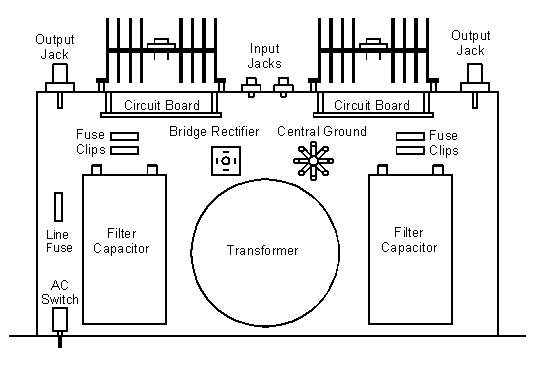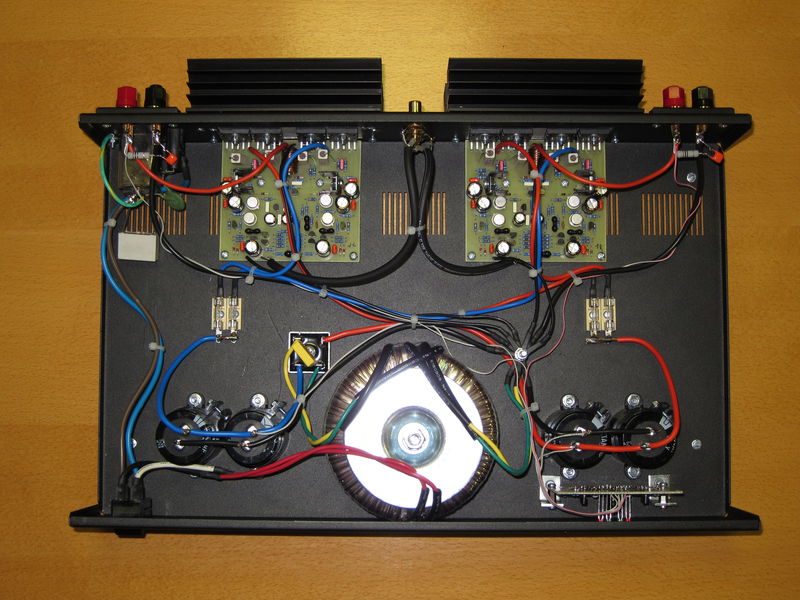when I power off the amp, it countinues to sound for 10-15 seconds, and there is not noise....
Once the AC is turned off, the AC interference stops.
Solve this by invoking the D.Joffe HBRR/HBRL
Interesting idea! What is it?
Member
Joined 2009
Paid Member
I'm still thinking along the same lines as I posted previously - here's a bit more detail behind my thinking: The high-impedance sensitive part of the amplifier is the input stage and the input stage has 4 ways for noise to get in i) the power supply (not likely in this case), ii) the feedback (not likely either), iii) the input signal (now looks unlikely based on your experiments), iv) the input ground (best guess this is the culprit). The input ground might pick up small signals from the power supply - perhaps because the speaker return current and signal ground meet at different points - did you try this change ??
Last edited:
I'm still thinking along the same lines as I posted previously - here's a bit more detail behind my thinking: The high-impedance sensitive part of the amplifier is the input stage and the input stage has 4 ways for noise to get in i) the power supply (not likely in this case), ii) the feedback (not likely either), iii) the input signal (now looks unlikely based on your experiments), iv) the input ground (best guess this is the culprit). The input ground might pick up small signals from the power supply - perhaps because the speaker return current and signal ground meet at different points - did you try this change ??
Very tired cause the late hour...explain please
A very good article by Andrew Russell on his web site:
How to Wire up an Audio Power Amplifier for Zero Noise Problems
The key thing is the "T" ground arrangement and the order of connecting the ground wires to it.
I used this approach in my CF-FET V2.0 amplifier - no ground loop issues whatsoever.
Dead silent.
How to Wire up an Audio Power Amplifier for Zero Noise Problems
The key thing is the "T" ground arrangement and the order of connecting the ground wires to it.
I used this approach in my CF-FET V2.0 amplifier - no ground loop issues whatsoever.
Dead silent.
An externally hosted image should be here but it was not working when we last tested it.
i'm planning to move the trafo near the front panel, keep out the 3 boards with bridges and capacitors and make a layout like in the picture. So trafo in the front middle of the case, left and right I'll place a single capacitor of 10kuf, and will use just one bridge and a star ground connected to the chassis.
actually the amp boards are not on the rear panel but will remain on the lateral sides on sinks, and also the rca socket will remain where they are now.
I'm thinking at this noise like a magnetic induction of the trafo that is picked up by the input cable 'cause when input are connected a sort of ground coil is created and it runs around the trafo...so it is INSIDE the coil. It can't be a ground loop, I have no masses that goes 2 times in the circuit. So I think AndrewT was right in advising me to use a twisted pair to minimize the picking up of noise
Do you think that with those mods I will solve the issue?

i'm planning to move the trafo near the front panel, keep out the 3 boards with bridges and capacitors and make a layout like in the picture. So trafo in the front middle of the case, left and right I'll place a single capacitor of 10kuf, and will use just one bridge and a star ground connected to the chassis.
actually the amp boards are not on the rear panel but will remain on the lateral sides on sinks, and also the rca socket will remain where they are now.
I'm thinking at this noise like a magnetic induction of the trafo that is picked up by the input cable 'cause when input are connected a sort of ground coil is created and it runs around the trafo...so it is INSIDE the coil. It can't be a ground loop, I have no masses that goes 2 times in the circuit. So I think AndrewT was right in advising me to use a twisted pair to minimize the picking up of noise
Do you think that with those mods I will solve the issue?
Depends on the way all these things are connected again
Even with one trafo, having two rectifier bridges with two sets of filtering capacitors, ensures significant soundstage improvement (less crosstalk). Using "T" grounding approach eliminates the ground loops.
Because of the huge and short current peaks circulating in the transformer, the bridge and the filter capacitors, I would put them all close to each other and then connect the middle point of the caps to the central ground. The smaller the aera where high current peaks circulate, the better. Moving the transformer from its central position to the left or right side of the case could help.
this Bonsai article has still not been corrected.A very good article by Andrew Russell on his web site:
How to Wire up an Audio Power Amplifier for Zero Noise Problems
...............
The "decoupling" resistor shown in the input wiring is inserted on the wrong side of the adjacent circuit node.
The resistor should be between the "Local Decoupling 0V" and the circuit node just to the left.
When placed in the correct position you will find that it is the same as Joffe's HBRR & HBRL.
This "loop" exists in two (or more) channel amplifiers. It cannot occur in mono-block amplifiers.
That's why many find the interference becomes audible when connecting the second Source to Receiver interconnect.
It is a specific issue ...only when rca are plugged
The purpose of the added resistor is to reduce the interference current in the loop between the Source outputs and the Receiving amplifier.
When this interfering current is attenuated, the voltage that current generates on any of the input circuit wires is also attenuated.
A reduction of 90% in interfering current will result in 20dB reduction of interference noise voltage.
A reduction of 99% leads to 40dB of noise attenuation.
the 15r shown in Bonsai's diagram would probably reduce interference current by about 99% compared to a loop resistance of 150milli-ohms.
Last edited:
Use a two wire Pair for EVERY circuit. Each module has TWO wires that connect to the next module. That connection MUST be done as a two wire connection. You can use coaxial using the braid as the Return connected at both ends, or use a twisted pair with both wires connected to the terminations at both ends, or a close coupled pair again with both ends connected at both ends. There are no exceptions.
I'll repeat:
Use a two wire Pair for EVERY circuit
When building a stereo power amplifier one usually ends up wiring in a loop in the return/grounding wires. Solve this by invoking the D.Joffe HBRR/HBRL to attenuate the interference current.
Read Joffe and HBRR/HBRL
this Bonsai article has still not been corrected.
The "decoupling" resistor shown in the input wiring is inserted on the wrong side of the adjacent circuit node.
The resistor should be between the "Local Decoupling 0V" and the circuit node just to the left.
When placed in the correct position you will find that it is the same as Joffe's HBRR & HBRL.
This "loop" exists in two (or more) channel amplifiers. It cannot occur in mono-block amplifiers.
That's why many find the interference becomes audible when connecting the second Source to Receiver interconnect.
The purpose of the added resistor is to reduce the interference current in the loop between the Source outputs and the Receiving amplifier.
When this interfering current is attenuated, the voltage that current generates on any of the input circuit wires is also attenuated.
A reduction of 90% in interfering current will result in 20dB reduction of interference noise voltage.
A reduction of 99% leads to 40dB of noise attenuation.
the 15r shown in Bonsai's diagram would probably reduce interference current by about 99% compared to a loop resistance of 150milli-ohms.
I have told you three times. Check for an input interconnect loop !OK
NOBODY KNOWS
Maybe this layout with 2 set of caps is better?

I still see single wires in your assembly.OK
NOBODY KNOWS
Maybe this layout with 2 set of caps is better?

Every circuit must use a close coupled PAIR !
I have told you three times. Check for an input interconnect loop !
There is not a loop!!!
LOOP ! not double ground.
I hate the word "ground", it means nothing to some and yet means everything to others.
Use unique names to identify the node/wire.
Most return wires of a signal pair are incorrectly called ground. eg. the speaker return wire, the input signal return wire, the power supply Zero Volts wire. All these are return routes for current that MUST RETURN to the Source. They are NOT "grounds".
I hate the word "ground", it means nothing to some and yet means everything to others.
Use unique names to identify the node/wire.
Most return wires of a signal pair are incorrectly called ground. eg. the speaker return wire, the input signal return wire, the power supply Zero Volts wire. All these are return routes for current that MUST RETURN to the Source. They are NOT "grounds".
- Status
- This old topic is closed. If you want to reopen this topic, contact a moderator using the "Report Post" button.
- Home
- Amplifiers
- Solid State
- Rod Elliot P3A amp noises